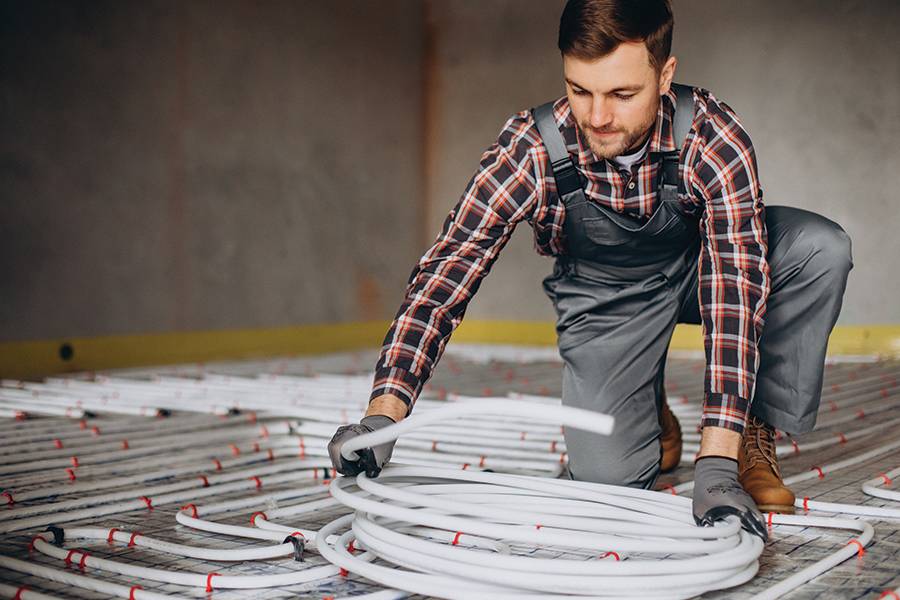Last month, we addressed the urgent sustainability challenge facing not only the tiling industry, but construction more broadly. While there are many sustainability advantages to tiles alone (their extremely long service life chief among them) there will need to be cooperation from the design stage through to the entire supply chain if buildings are to become truly sustainable.
That’s one reason why it’s so encouraging to see the growing popularity of underfloor heating, a technology which offers a number of sustainability benefits – especially when used in conjunction with ceramic and porcelain tiles.
In fact, according to BEAMA (the UK’s national trade association for underfloor heating) stone and ceramic tiles outperform every other floorcovering when used with underfloor heating. “This high-density material is the best floor material to use with UFH, allowing the heat from the pipework to easily flow to the rest of the room, with excellent heat transfer properties,” the association says in its Choosing Your Floor Covering To Maximise Your Underfloor Heating Efficiency document.
“Increasing the thickness of the tile will have little effect on the heat output, but it will slightly increase the heat up time. With stone (which includes slate) and ceramic tiles, it is always advisable to use a de-coupling membrane and flexible adhesive to reduce the potential for any hairline expansion cracks.”
Less power, more heat
But why is underfloor heating any more sustainable than alternative heating options? Again from BEAMA: “Although radiators have traditionally been the most widely used heat emitter, they largely emit heat by convection. Underfloor heating, on the other hand, emits a higher percentage of heat by radiation. This, combined with the large surface area of the floor, means that dwellings using underfloor heating can heat effectively using lower flow temperatures than those using other heat emitters whilst ensuring occupants have the same perception of warmth.”
To put it simply, underfloor heating can be used at a lower temperature than radiators to provide the same level of heat. This means, according to BEAMA’s data, UFH systems are up to 20% more efficient than radiators for heating rooms. The cumulative environmental benefit of this 20% efficiency gain (not to mention the lower running cost) is becoming increasingly attractive to specifiers and homeowners alike.
Of course, as the association notes: “Consumer education is also key to making the most of an underfloor heating system. It is important to convey to occupants that an underfloor heating system works in a different way to a traditional radiator heating system, which are generally switched on and off more frequently and can be hot to the touch.” The role of the installer in both properly dealing with underfloor heating, as well as making the customer aware of everything they need to know, should not be underestimated. That said, underfloor heating is a dense and complex topic that tilers have sometimes regarded as more trouble than it’s worth. Luckily, thanks to efforts across the industry, that perception is rapidly changing.
Installation
Fortunately, although it does require some special consideration, there are now more resources than ever available to help tilers work on floors which feature underfloor heating. Indeed, in this very issue we have published seven tips from Steven Rooney, the director of Amber Underfloor Heating, for tilers carrying out installations over these systems. Many back issues of TSJ (all available as free digital readers on our website) also contain specific and general advice for tiling over underfloor heating.
Moreover, TTA provides an in-depth technical document (Tiling to Heated Systems) to its members which covers the topic in extreme detail, strictly based on British Standards. This document covers the necessary preparatory work, correct tile fixing methods, adhesive and grout, heat commissioning and ongoing maintenance.
Elsewhere, Sam Hoffman of the Tilers Community collaborated with Amber to create a holistic guide for tilers working with underfloor heating. Hoffman suggested that, in the past, tilers might have been apprehensive to take on a job which involved underfloor heating if they lacked the proper knowledge or training to work with it. Now, however, there’s such a plethora of free resources on the topic that there’s no reason for any tiler to shy away from this growing market segment! g
www.beama.org.uk
www.tiles.org.uk/services/technical-publications/








